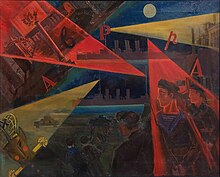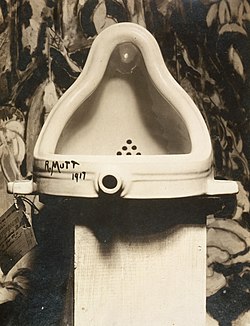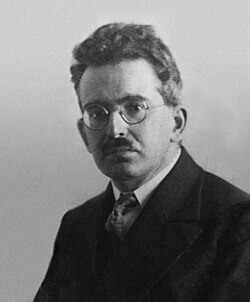Avant-garde
This article's factual accuracy is disputed. (August 2023) |

In
As a stratum of the intelligentsia of a society, avant-garde artists promote progressive and radical politics and advocate for societal reform with and through works of art. In the essay "The Artist, the Scientist, and the Industrialist" (1825) Benjamin Olinde Rodrigues's political usage of vanguard identified the moral obligation of artists to "serve as [the] avant-garde" of the people, because "the power of the arts is, indeed, the most immediate and fastest way" to realise social, political, and economic reforms.[4]
In the realm of culture, the artistic experiments of the avant-garde push the aesthetic boundaries of
History

The French military term avant-garde (advanced guard) identified a
In the U.S. of the 1960s, the post–WWII changes to American culture and society allowed avant-garde artists to produce works of art that addressed the matters of the day, usually in political and sociologic opposition to the cultural conformity inherent to popular culture and to consumerism as a way of life and as a worldview.[8]
Theories
In The Theory of the Avant-Garde (Teoria dell'arte d'avanguardia, 1962), the academic Renato Poggioli provides an early analysis of the avant-garde as art and as artistic movement.[9] Surveying the historical and social, psychological and philosophical aspects of artistic vanguardism, Poggioli's examples of avant-garde art, poetry, and music, show that avant-garde artists share some values and ideals as contemporary bohemians.[10]
In Theory of the Avant-Garde (Theorie der Avantgarde, 1974), the literary critic Peter Bürger looks at The Establishment's embrace of socially critical works of art as capitalist co-optation of the artists and the genre of avant-garde art, because "art as an institution neutralizes the political content of the individual work [of art]".[11]
In Neo-avantgarde and Culture Industry: Essays on European and American Art from 1955 to 1975 (2000),
Society and the avant-garde

(Alfred Stieglitz)


Sociologically, as a stratum of the
Walter Benjamin in the essay "
In
Parting from the claims of Greenberg in the late 1930s and the insights of Poggioli in the early 1960s, in The De-Definition of Art: Action Art to Pop to Earthworks (1983), the critic
Avant-garde is frequently defined in contrast to arrière-garde, which in its original military sense refers to a rearguard force that protects the advance-guard.[23] The term was less frequently used than "avant-garde" in 20th-century art criticism.[24] The art historians Natalie Adamson and Toby Norris argue that arrière-garde is not reducible to a kitsch style or reactionary orientation, but can instead be used to refer to artists who engage with the legacy of the avant-garde while maintaining an awareness that doing so is in some sense anachronistic.[25] The critic Charles Altieri argues that avant-garde and arrière-garde are interdependent: "where there is an avant-garde, there must be an arrière-garde."[26]
Examples
Music
Avant-garde in music can refer to any form of music working within traditional structures while seeking to breach boundaries in some manner.[27] The term is used loosely to describe the work of any musicians who radically depart from tradition altogether.[28] By this definition, some avant-garde composers of the 20th century include Arnold Schoenberg,[29] Richard Strauss (in his earliest work),[30] Charles Ives,[31] Igor Stravinsky,[29] Anton Webern,[32] Edgard Varèse, Alban Berg,[32] George Antheil (in his earliest works only), Henry Cowell (in his earliest works), Harry Partch, John Cage, Iannis Xenakis,[29] Morton Feldman, Karlheinz Stockhausen,[33] Pauline Oliveros,[34] Philip Glass, Meredith Monk,[34] Laurie Anderson,[34] and Diamanda Galás.[34]
There is another definition of "Avant-gardism" that distinguishes it from "modernism": Peter Bürger, for example, says avant-gardism rejects the "institution of art" and challenges social and artistic values, and so necessarily involves political, social, and cultural factors.[28] According to the composer and musicologist Larry Sitsky, modernist composers from the early 20th century who do not qualify as avant-gardists include Arnold Schoenberg, Anton Webern, and Igor Stravinsky; later modernist composers who do not fall into the category of avant-gardists include Elliott Carter, Milton Babbitt, György Ligeti, Witold Lutosławski, and Luciano Berio, since "their modernism was not conceived for the purpose of goading an audience."[35]
The 1960s saw a wave of free and avant-garde music in jazz genre, embodied by artists such as Ornette Coleman, Sun Ra, Albert Ayler, Archie Shepp, John Coltrane and Miles Davis.[36][37] In the rock music of the 1970s, the "art" descriptor was generally understood to mean "aggressively avant-garde" or "pretentiously progressive".[38] Post-punk artists from the late 1970s rejected traditional rock sensibilities in favor of an avant-garde aesthetic.
Theatre
Whereas the avant-garde has a significant history in 20th-century music, it is more pronounced in theatre and performance art, and often in conjunction with music and sound design innovations, as well as developments in visual media design. There are movements in theatre history that are characterized by their contributions to the avant-garde traditions in both the United States and Europe. Among these are
Architecture
Brutalist architecture was greatly influenced by an avant-garde movement.[39]
Art movements
- Abstract expressionism
- Artivism
- COBRA
- Conceptual art
- Constructivism
- Cubism
- Dadaism
- De Stijl
- Expressionism
- Fauvism
- Fluxus
- Futurism
- Happening
- Imaginism
- Imagism
- Impressionism
- Incoherents
- Land art
- Les Nabis
- Lyrical Abstraction
- Minimal art
- Neo-Dada
- Orphism
- Pop art
- Precisionism
- Primitivism
- Rayonism
- Situationism
- Suprematism
- Surrealism
- Symbolism
- Tachisme
- Universal Constructivism
- Viennese Actionism
- Vorticism
- Creationism
- Nadaism
- Stridentism
- Ultraist
See also
References
- YouTube
- ^ Avant-garde, Penguin Dictionary of Literary Terms and Literary Theory Third Edition (1991) J.A. Cuddon Ed. p. 74.
- ^ Avant-garde, A Handbook to Literature (1980) Fourth Ed. (1980) C. Hugh Holman, Editor. pp. 41–42.
- ^ Calinescu, Matei. The Five Faces of Modernity: Modernism, Avant-Garde, Decadence, Kitsch, Postmodernism Archived 14 April 2022 at the Wayback Machine (Durham: Duke University Press, 1987) pp. 00-00.
- ^ Modernism, Penguin Dictionary of Literary Terms and Literary Theory Third Edition (1991) J.A. Cuddon Ed. p.p.550–551.
- ^ Avant-garde, Williams, Raymond. "The Politics of the Avant-Garde", The Politics of Modernism (Verso 1989) p. 000.
- OCLC 53144738.
- JSTOR j.ctv11smn4s. Archivedfrom the original on 11 October 2022. Retrieved 11 October 2022.
- ISBN 978-94-012-0252-7.
- ISBN 0-674-88216-4., translator Gerald Fitzgerald
- ^ Peter Bürger (1974). Theorie der Avantgarde. Suhrkamp Verlag. English translation (University of Minnesota Press) 1984: 90.
- ISBN 0-262-02454-3.
- ^ "avant-garde", Penguin Dictionary of Literary Terms and Literary Theory Third Edition (1991) J.A. Cuddon, Ed. p.74.
- ^ Greenberg, Clement (Fall 1939). "Avant-Garde and Kitsch". The Partisan Review. Vol. 6, no. 5. pp. 34–49. Archived from the original on 4 July 2018. Retrieved 24 January 2018.
- ^ Walter Benjamin, "The Work of Art in the Age of Mechanical Reproduction" Archived 5 December 2006 at the Wayback Machine[full citation needed]
- ^ a b Adorno, Theodor (1991) [1975]. "Culture industry reconsidered" (PDF). The Culture Industry: Selected Essays on Mass Culture. London: Routledge. Archived from the original on 29 September 2018. Retrieved 16 March 2023.
- ^ Richard Schechner, "The Conservative Avant-Garde." New Literary History 41.4 (Autumn 2010): 895–913.
- from the original on 15 January 2023. Retrieved 14 September 2022.
- ^ "The Idea of the Postmodern: A History". Routledge & CRC Press. Archived from the original on 7 June 2022. Retrieved 14 September 2022.
- ^ Calinescu 1987,[page needed]; Bertens 1995.[page needed]
- ISBN 0-226-72673-8
- ^ Dickie, George. ""Symposium on Marxist Aesthetic Thought: Commentary on the Papers by Rudich, San Juan, and Morawski Archived 30 May 2013 at the Wayback Machine", Arts in Society: Art and Social Experience: Our Changing Outlook on Culture 12, no. 2 (Summer–Fall 1975): p. 232.
- ^ Adamson, Natalie; Norris, Toby (2009). "Introduction". In Adamson, Natalie; Norris, Toby (eds.). Academics, Pompiers, Official Artists and the Arrière-Garde: Defining Modern and Transitional in France. Cambridge Scholars Publishing. p. 18.
- ^ Adamson & Norris 2009, pp. 17–18.
- ^ Adamson & Norris 2009, pp. 18–19, 20.
- JSTOR 1773194.
- ISBN 978-0-521-54554-9
- ^ John Tyrrell(London: Macmillan Publishers, 2001).
- ^ ISBN 0-313-29689-8.
- ISBN 0-313-29689-8.
- ISBN 0-313-29689-8.
- ^ ISBN 0-313-29689-8.
- ISBN 0-306-80819-6
- ^ ISBN 0-313-29689-8.
- ISBN 0-313-29689-8.
- ^ "Avant-Garde Jazz Music Genre Overview". AllMusic. Retrieved 16 March 2023.
- ^ Michael West. "In the year jazz went avant-garde, Ramsey Lewis went pop with a bang". The Washington Post. Archived from the original on 6 September 2020. Retrieved 30 May 2020.
- ^ Murray, Noel (28 May 2015). "60 minutes of music that sum up art-punk pioneers Wire". The A.V. Club. Archived from the original on 31 October 2015. Retrieved 30 May 2020.
- ISSN 2075-5309.
Further reading
- Robert Archambeau. "The Avant-Garde in Babel. Two or Three Notes on Four or Five Words", Action-Yes vol. 1, issue 8, Autumn 2008.
- Bäckström, Per (ed.), Centre-Periphery. The Avant-Garde and the Other, Nordlit. University of Tromsø, no. 21, 2007.
- Bäckström, Per. "One Earth, Four or Five Words. The Peripheral Concept of 'Avant-Garde'", Action-Yes vol. 1, issue 12, Winter 2010.
- Bäckström, Per & Bodil Børset (eds.), Norsk avantgarde (Norwegian Avant-Garde), Oslo: Novus, 2011.
- Bäckström, Per & Benedikt Hjartarson (eds.), Decentring the Avant-Garde, Amsterdam & New York: Rodopi, Avantgarde Critical Studies, 2014.
- Bäckström, Per and Benedikt Hjartarson. "Rethinking the Topography of the International Avant-Garde", in Decentring the Avant-Garde, Per Bäckström & Benedikt Hjartarson (eds.), Amsterdam & New York: Rodopi, Avantgarde Critical Studies, 2014.
- Barron, Stephanie, and Maurice Tuchman. 1980. The Avant-garde in Russia, 1910–1930: New Perspectives: Los Angeles County Museum of Art [and] ISBN 0-262-20040-6(pbk.)
- Bazin, Germain. 1969. The Avant-garde in Painting. New York: Simon and Schuster. ISBN 0-671-20422-X
- Berg, Hubert van den, and Walter Fähnders (eds.). 2009. Metzler Lexikon Avantgarde. Stuttgart: Metzler. ISBN 3-476-01866-0(in German)
- Crane, Diana. 1987. The Transformation of the Avant-garde: The New York Art World, 1940–1985. Chicago: ISBN 0-226-11789-8
- Daly, Selina, and Monica Insinga (eds.). 2013. The European Avant-garde: Text and Image. Newcastle upon Tyne: Cambridge Scholars. ISBN 978-1-4438-4054-5.
- Fernández-Medina, Nicolás, and Maria Truglio (eds.). Modernism and the Avant-garde Body in Spain and Italy. Routledge, 2016.
- Harding, James M., and John Rouse, eds. Not the Other Avant-Garde: The Transnational Foundations of Avant-Garde Performance. University of Michigan, 2006.
- Hjartarson, Benedikt. 2013. Visionen des Neuen. Eine diskurshistorische Analyse des frühen avantgardistischen Manifests. Heidelberg: Winter.
- Kostelanetz, Richard, and H. R. Brittain. 2000. A Dictionary of the Avant-Gardes, second edition. New York: Schirmer Books. ISBN 0-415-93764-7(pbk.)
- Kramer, Hilton. 1973. The Age of the Avant-garde; An Art Chronicle of 1956−1972. New York: Farrar, Straus and Giroux. ISBN 0-374-10238-4
- Léger, Marc James (ed.). 2014. The Idea of the Avant Garde—And What It Means Today. Manchester and New York: Manchester University Press; Oakland: Left Curve. ISBN 978-0-7190-9691-4.
- Maerhofer, John W. 2009. Rethinking the Vanguard: Aesthetic and Political Positions in the Modernist Debate, 1917–1962. Newcastle upon Tyne: Cambridge Scholars Press. ISBN 1-4438-1135-1
- Mann, Paul. The Theory-Death of the Avant-Garde. Indiana University Press, 1991. ISBN 978-0-253-33672-9
- Novero, Cecilia. 2010. Antidiets of the Avant-Garde: From Futurist Cooking to Eat Art. (University of Minnesota Press) ISBN 978-0-8166-4601-2
- Pronko, Leonard Cabell. 1962. Avant-garde: The Experimental Theater in France. Berkeley: University of California Press.
- Roberts, John. 2015. Revolutionary Time and the Avant-Garde. London and New York: Verso. ISBN 978-1-78168-913-4(pbk).
- Schechner, Richard. "The Five Avant-Gardes or ... [and] ... or None?" The Twentieth-Century Performance Reader, 2nd ed., ed. Michael Huxley and Noel Witts (New York and London: Routledge, 2002).
- Schmidt-Burkhardt, Astrit. 2005. Stammbäume der Kunst: Zur Genealogie der Avantgarde. Berlin ISBN 3-05-004066-1[online version is available]
- Sell, Mike. The Avant-Garde: Race, Religion, War. Seagull Books, 2011.
- Shishanov, V. A. 2007. (in Russian)
External links
- Historic Avant-Garde Periodicals for Digital Research, The Blue Mountain Project, Princeton University Library
- Avant-garde and Modernist Magazines (Monoskop)
- Magazines in Bibliothèque Kandinsky, Centre Pompidou, Paris Archived 26 July 2020 at the Wayback Machine
- Periodicals in Iowa Digital Library, University of Iowa Libraries
- Digital Dada Library of International Dada Archive, University of Iowa Libraries
- Magazines in Digital Collections of Beinecke Rare Book & Manuscript Library
- Avant-Garde Periodicals Meet Digital Archives, New York Public Library
- Dada, Surrealism, and De Stijl Magazines on UbuWeb Historical
- Index of Modernist Magazines, Davidson College Archived 30 August 2016 at the Wayback Machine
- Modernist Journal Project, Brown University and University of Tulsa
- Spanish and Italian Modernist Studies Forum, Pennsylvania State University Archived 20 August 2016 at the Wayback Machine
- Collection: "Spanish Avant-Garde" from the University of Michigan Museum of Art
